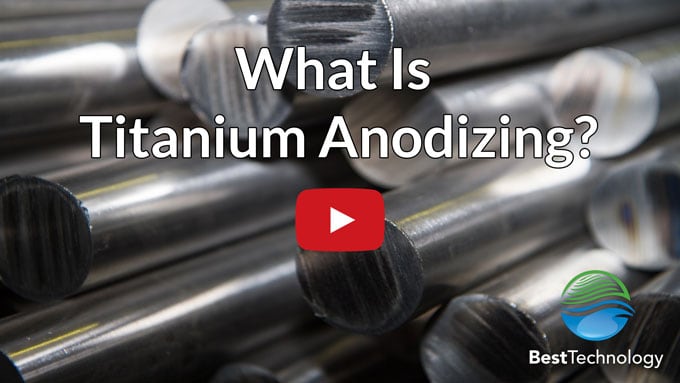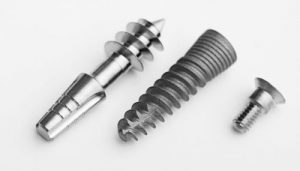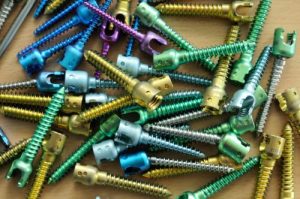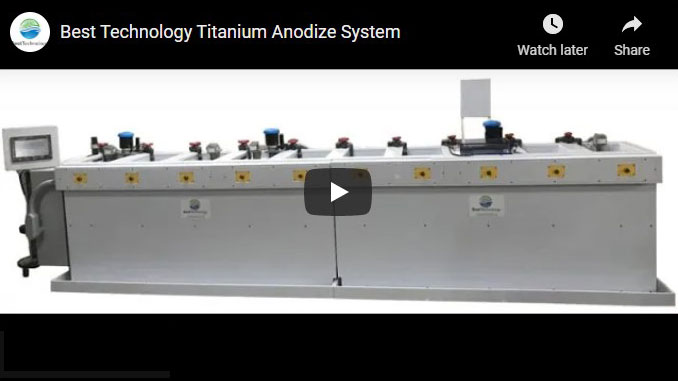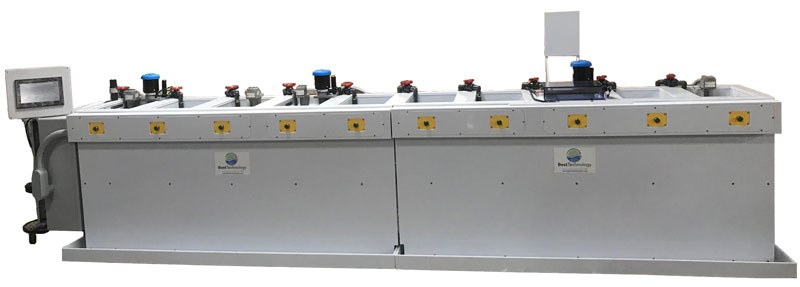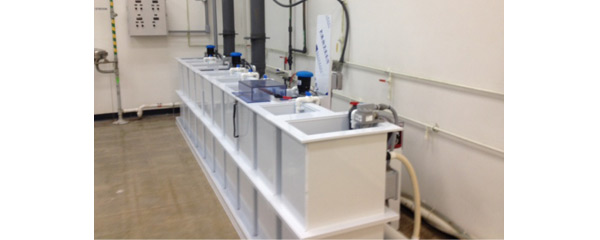What is Titanium Anodizing?
Titanium anodizing is an electrolytic finishing process that manipulates the oxide layer on the surface of titanium via electric current. The titanium item forms the anode (positive electrode) of an electrolytic cell; hence the name “anodize.”
Anodizing has a long history in the aerospace industry, where it was first used in 1923 to protect British seaplane parts from salt-water corrosion. Aerospace companies continue to use anodizing processes today to protect metals from effects of aging, wear and corrosion.
Understanding how to anodize titanium is critical for ensuring consistent color, corrosion resistance, and biocompatibility. The process begins with a thorough cleaning of the titanium surface to remove oils, oxides, and contaminants. Once cleaned, the parts are submerged in an electrolytic bath, and a precise voltage is applied. Different voltages produce specific interference colors due to variations in the oxide layer thickness, making titanium anodizing especially valuable for color coding in medical and aerospace applications.
When exploring how to anodize titanium, it’s important to consider the electrolyte composition, voltage range, and material surface preparation. Variables such as part geometry and desired color consistency also play a role. Manufacturers seeking guidance on how to anodize titanium for repeatable and high-quality results often rely on dedicated anodizing systems with voltage control, consistent agitation, and cleanroom-compatible setups to meet regulatory and application-specific requirements.
The medical device industry also widely uses the titanium anodizing process, since anodized titanium parts are nontoxic and suitable for biomedical applications, such as orthopedic implants. Knowing how to anodize titanium using repeatable voltage controls allows for better traceability in medical manufacturing environments.
Knowing how to anodize titanium effectively requires both process knowledge and tight environmental controls.
- Related article: Titanium Anodizing Equipment
Video: What Is Titanium Anodizing?
Types of Titanium Anodizing
There are two commonly used types of titanium anodizing: Type 2 and Type 3. Type 1 is far less common, and is used in specialized high-temperature treatments.
Type 2 Anodized Titanium – Wear Resistance
Type 2 is mainly for wear purposes: It protects the metal surface against the effects of wear. When untreated titanium parts rub against each other, they produce titanium dust – a result that is not desirable with orthopedic implants, for example. Type 2 anodizing provides a wear-resistant surface and helps prevent seizing or friction between sliding titanium surfaces.
The reduced friction, or lubricity, from Type 2 anodized titanium also helps patients with orthopedic implants by improving mobility of joints.
For most Type 2 titanium anodizing lines, AMS 2488 is the applicable specification. SAE International, the aerospace standards organization, is the governing authority for the specification for Type 2, which was last revised in 2019.
For engineers and manufacturers focused on surface durability, learning how to anodize titanium for wear resistance is essential. The Type 2 anodizing process enhances the titanium oxide layer without introducing color, resulting in a hard, lubricious surface ideal for high-friction environments. When considering how to anodize titanium for AMS 2488 compliance, process control is key voltage, electrolyte chemistry, and part preparation must be tightly regulated to achieve consistent, high-performance coatings.
Workshops on how to anodize titanium are recommended for engineers implementing new anodizing lines for orthopedic applications.
For aerospace applications, Type 2 anodized parts are compatible with aircraft fluids and can withstand extreme temperatures within a range of -70 °F to 260 °F. Type 2 anodized titanium resists corrosion from exposure to salt water and humidity.
Type 2 anodized titanium parts are a distinctive gray color. This makes them easily distinguished from stainless steel, or from color anodized titanium.
In this photo of dental implant hardware, the middle screw has a Type 2 anodized titanium finish.
It should be noted that Type 2 titanium anodizing requires additional processing in comparison to Type 3. After Type 2 titanium anodizing, the parts will come out with a white film. Bead blasting is a necessary final step to remove the white film and achieve the characteristic gray finish on the titanium part.
Type 3 Titanium Anodizing – Color Titanium
Type 3 titanium anodizing is also called titanium color anodizing. Type 3 color anodizing is widely used in the medical world for quick visual identification of parts. For example, an orthopedic surgeon in mid-procedure can simply ask for a blue bone screw, without having to specify the 12 mm length of the screw.
Another example of color coding to assist doctors and physicians is bone fixation plates that an orthopedic surgeon uses to treat trauma fractures. These bone fixation plates have drill guides of different colors to indicate the anatomical difference between the left and right plates.
Type 3 titanium color anodizing is less common in the aerospace industry, but sometimes is used for quick visual identification in complicated assemblies.
Outside the medical device and aerospace industries, Type 3 colored titanium finishes are also used in jewelry manufacturing.
Titanium Color Chart
In contrast to Type 2, Type 3 titanium color anodizing lacks an overarching industry specification. AMS 2488 does not address color anodizing, and no industry-wide standards exist to define specific colors in the Type 3 spectrum. This makes color matching of parts from one batch to another a real challenge.
The lack of standards for Type 3 titanium color anodizing means that manufacturers must build their own process validation from the ground up, rather than starting with the framework offered by an industry specification. Best Technology’s process equipment experts offer process validation consulting services for manufacturers installing a new Type 3 titanium anodizing line.
Understanding the role of voltage in producing consistent titanium color outcomes is essential for production-line success.
Manufacturers often reference a standardized titanium color chart to visually confirm results before packaging.
Best Practices for Color Anodizing
When learning how to anodize titanium, avoid switching voltage levels mid-cycle to prevent streaking or uneven oxide layers.
Photographic records of titanium color results can serve as useful references for future process tuning and quality control.
For optimal results, anodizing technicians must know exactly how to anodize titanium at each voltage step to match customer expectations.
Video: Titanium Anodizer System
Key Differences between Type 2 and Type 3 Titanium Anodizing
Titanium finishes differ significantly between Type 2 and Type 3 titanium anodizing.
| Type 2 | Type 3 | |
| Primary Benefit | Avoid friction between metal surfaces | Provide quick visual identification of parts |
| Specification | AMS 2488 | None defined |
| Biocompatible for medical device implants | Yes | Yes |
| Improved wear resistance | Yes | No |
| Anti-galling / increased lubricity | Yes | Some |
| Color | Gray | Variety of colors. Typical range includes:
|
How Does Anodizing Work with Titanium?
Anodizing is an electrochemical process that uses both electricity and chemistry to manipulate the oxide layer of titanium. The titanium part, serving as the anode (positive electrode), is immersed in an aqueous electrolyte solution such as trisodium phosphate (TSP) or various salts. When electrical current is applied, water molecules undergo hydrolysis and split into hydrogen and oxygen. The electrical potential forces the oxygen to the titanium surface, adding to the thin layer of titanium oxide. For color anodizing, the final perceived color depends on the thickness of the oxide layer, which can be adjusted by varying the voltage and the immersion time.
How Does Titanium Color Anodizing Work?
A titanium anodizer machine manipulates the oxide layer on the surface of titanium to produce an “illusion of color.” The titanium oxide layer gives the perception of color due to an interference phenomenon, similar to a prism. Light reflects from both the oxide layer and the underlying titanium at different angles and those reflections interfere with each other. Certain wavelengths of light cancel each other out or combine, so that the remaining light is perceived as color. Unlike aluminum anodizing, no dyes are required to produce the color perception, thus adding to the biomedical safety of the finished part.
An oxide layer forms naturally on the surface of titanium upon exposure to the atmospheric conditions, as oxygen reacts with the surface of titanium. This process of oxidation naturally occurs with many elements and the thin protective oxide layer helps protect it from further reactions to air or water.
When it first forms, the oxide layer is about 1-2 nanometers thick (10-20 angstroms), but it will continue to grow in open air. Without anodizing, the oxide layer typically grows to 20-25 nanometers (200-250 angstroms).
In color titanium anodization, however, the thickness of the oxide layer is augmented and manipulated. For example, the color bronze – the thinnest color layer on the titanium color spectrum – can be achieved by building the oxide layer thickness to about 300 to 350 angstroms. At the other end of the titanium color spectrum, the color green – the thickest color layer – can be achieved with an oxide layer thickness of 500 to 550 angstroms.
Since the entire range of color for the titanium oxide layer is within 25 billionths of a meter (a nanometer is 1-billionth of a meter), it is little wonder that the process requires careful precision and high-quality anodizing equipment to reach the best results.
It should be noted that not every color can be produced with titanium anodizing. In particular, red anodized titanium is not possible due to the physics of the optical interference phenomenon. The nearest available colors to red would be magenta, rose (reddish violet) or purple.
Anodizing Equipment and Tanks for Titanium Color Anodize
How To Do Type 3 Color Titanium Anodizing
Chemistry
In Type 3 color anodizing, a titanium part is immersed in an electrolyte solution. The most common chemistry uses trisodium phosphate (TSP), forming an alkaline solution; however, there are many options. The chemistry serves to provide ions for the electrolytic process, but it does not directly affect the titanium surface.
Electricity
The electrical part of the anodizing process requires a specialized rectifier, an electrical device that converts alternating current (AC) to direct current (DC). The rectifier allows you to regulate the voltage to a level that you specify and to control the amperage.
In titanium anodizing, the voltage dictates the color. The volt range for color titanium anodizing is between 15 and 110 volts. A bronze color, with the thinnest oxide layer, can be achieved with about 16 volts. A green color, with the thickest oxide layer, can be achieved with 106 volts.
In contrast, the amperage dictates the time required. By increasing the amperage, the oxide layer forms more quickly. But the increased amperage carries a risk of inconsistency in color output, because it can become too difficult to stop the oxide layer buildup at the correct color. Product size drives the amperage; typically, the larger the product, the more amperage is used.
Process Steps for Titanium Anodizing
Best Technology and its partners have developed custom chemical blends of solutions and electrolytes that greatly increase the manufacturing yield of this process, which are not offered by anyone else in the industry. The chemistry for a titanium anodizing line includes both cleaning and electrochemical electrolytes.
For manufacturers looking to take their titanium color anodizing in-house and build their own Type 3 color anodize line, here is an example of process steps:
- High alkaline clean – A general washing in a high-alkaline cleaner ensures that any organics are removed. Organics block the anodize prep step and prevent an even, consistent color.
- Cold rinse – Ensure any alkaline detergents are removed from the part. It’s recommended to perform a water-break test. (Water should sheet off the part, not bead off. Beading off means there is still oil or grease on the part and will cause failure in anodizing.)
- Hot rinse
- Anodize Prep – Preparing the surface of the titanium to receive the oxide layer is the most important step of the process. To achieve consistent color, the oxide layer must be distributed evenly throughout the surface of the part. There are many different options for prep chemistry, for example:
- Nitric and hydrofluoric acid
- Nitric acid
- Hydrochloric acid, etc.
- Cold rinse
- Alkaline neutralization
- Cold rinse
- Anodize Process – Trisodium phosphate (TSP)
- Cold rinse
- Hot rinse
Titanium Anodizing Best Practices
Surface preparation, also called anodize prep, is crucial for achieving consistent color for titanium. The titanium surface must be prepared in a way that supports the even distribution of the oxide layer. Anodize prep requires removing a thin layer of material to create a uniform surface for color anodizing. The titanium grade determines the level of prep; the purer grades of titanium such as grade 2 require more aggressive surface prep than titanium alloys such as grade 5, titanium 6AI-4V.
Timing is critical after surface preparation. The anodize process should occur almost immediately after the anodize prep. Otherwise within 6-8 hours of exposure to oxygen (air, water) the oxide layer will form apart from anodizing. Anodizing parts after the oxide layer has already formed results in a splotchy color pattern that is not desirable.
Surface finish is one of the biggest factors that can affect the appearance of color. If the part is machined poorly, some of the surface areas can become work-hardened or smeared. Upon application of electricity, the work-hardened or smeared area slows down the electrical current, and the resulting color is inconsistent and not harmonious. For example, the titanium part might have magenta coloration with gold spots, or a blue coloration with bronze spots.
The titanium metal finish also dictates the brilliance of the final color. In other words, if the titanium part has a blasted surface finish before anodizing, the finished part will continue to have a matte appearance after anodizing. Unlike Type 2, the titanium color anodize process does not affect the brilliance of the surface finish.
Recovering from Mistakes in Color Titanium Anodizing
Because anodizing involves manipulating the oxide layer on titanium, that layer can easily be stripped with a high-alkaline cleaner. This makes it relatively easy to recover from mistakes in color anodizing. To recover from the following types of issues, strip the oxide layer with a high-alkaline cleaner, and then repeat the anodize prep and anodize process.
- Over-anodizing: For example, if a part reaches a magenta color but was intended to be a gold color.
- Non-harmonious color or splotchy color due to delay between anodize prep and anodize process.
Processing the parts in titanium anodizer equipment specifically made for color titanium anodizing helps control the process to achieve consistent titanium colors.
Titanium Anodizing FAQs
-
Does Anodized Titanium Fade?
Anodized titanium is a popular material used in various applications, from aerospace and medical devices to automotive and jewelry. The titanium undergoes an electrochemical process that creates an oxide layer on its surface. For color anodizing applications (Type 3), the color is achieved by altering the thickness of the oxide layer, which can range from about 300 to 550 angstroms (30-55 nanometers).
The color in titanium anodizing is not a coating or a paint, nor does it use pigment or dye that can peel or fade over time. The prismatic effect in the oxide layer does not degrade with exposure to UV light. So in that sense, no, anodized titanium does not fade. But the surface of the titanium is subject to abrasion.
Does Anodized Titanium Wear Off?
The oxide layer of color anodized titanium may be scratched or scraped off from the effects of friction and wear, and thus remove the color. Unlike Type 2 titanium anodizing, Type 3 color anodizing does not protect from the effects of wear. Exposure to conditions such as harsh chemicals, abrasives or high temperatures may cause the titanium to lose its color or become discolored. In some cases, repeated small abrasions may lead to what could be mistaken for faded color.
Because anodized titanium is biocompatible, it is often used for orthopedic implants. A titanium anodized part will lose its color within 48-72 hours after implantation in the human body. Laser marking the titanium part after color anodizing is an important step for traceability and identification if the implant later needs to be removed.
For quality control in manufacturing, a typical guideline for anodized titanium implants is that they must survive three rounds in an autoclave without deterioration of color.
-
Passivation vs. Anodizing: Understanding the Differences
In the world of metal surface treatment, passivation and anodizing are two critical processes that enhance the durability and corrosion resistance of metal parts. Understanding the differences between these processes can help industries choose the right method for their specific needs.
What is Passivation?
Passivation is a chemical process that removes free iron from the surface of stainless steel, forming a protective oxide layer. This layer enhances the metal’s corrosion resistance, making it ideal for applications in harsh environments. The process is particularly beneficial for stainless steel passivation, ensuring long-lasting protection against rust and other forms of corrosion.
What is Anodizing?
Anodizing, on the other hand, is an electrolytic process that increases the thickness of the natural oxide layer on the surface of metal parts, typically aluminum. This process not only improves corrosion resistance but also enhances the metal’s aesthetic appeal by allowing for various color finishes. Anodizing is widely used in industries where both durability and appearance are crucial.
Key Differences
While both processes aim to protect metal surfaces, they differ in their applications and outcomes. Passivation is primarily used for stainless steel, focusing on removing contaminants and enhancing corrosion resistance. Anodizing, however, is more versatile, offering both protective and decorative benefits, especially for aluminum and titanium parts.
Choosing the Right Process
The choice between passivation and anodizing depends on the material and the desired outcome. For stainless steel components exposed to corrosive environments, passivation is the preferred method. In contrast, anodizing is ideal for aluminum and titanium parts where both protection and aesthetics are important.
In conclusion, understanding the differences between passivation and anodizing is essential for industries seeking to enhance the performance and longevity of their metal components. By selecting the appropriate process, businesses can ensure their products meet the highest standards of quality and durability.
For more information on how Best Technology can assist with your metal surface treatment needs, visit our Passivation Systems and Surface Finishing Systems pages.
Equipment for Anodizing Titanium
Medical device manufacturers depend on Best Technology’s expertise for process design and development with anodizing machines that are designed for safe use with the required chemistries to anodize titanium. With equipment from Best Technology, you can achieve the best possible titanium finishes.
Best Technology has the experience and the resources to build Ti anodize tanks and equipment, and to develop processes for Ti anodizing applications both large and small. Let our application engineers design a titanium anodizing line for your products. Contact us to learn more and start your project today!

